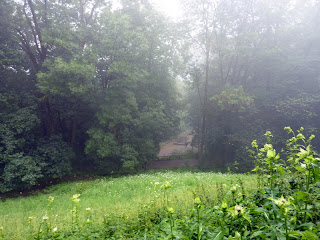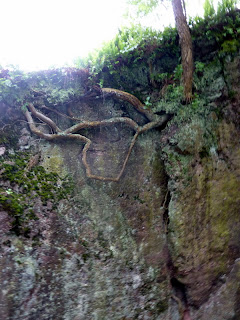After we had changed and dried out from the morning walk in the thunderstorm, Frau Heller dropped us off at the parking area by Wartburg Castle, and we walked rest of the way up. Parts in quotations are excerpts from signs around the palace:
The view of the castle from below, the forests on the way up, and the city and valley below were phenomenal.
The well from the middle of the courtyard which was right next to the Knight's bath:
"Knights' Bath: The main castle building and other surviving structures were resored between 1838 and 1891. Parts of the castle that had been lost, for example the keep and the heated hall building, were reconstructed in their historical form. The final undertaking was the neo-Romanesque Knights' Bath designed by Wartburg architect Hugo von Ritgen (1811-1889) After the eastern custom of bathing was introduced to western and central Europe by the Crusaders, a bath becamse a requirement for royal households. Ritgen knew from medieval sources that there had been a bathing cubicle at Wartburg Castle and assumed, probably correctly, that its original location was near the cistern, adjoining the main building to the south. " He based his designs on the preserved baths at Friedberg (Hessen) and Girona (Spain.) The 1989 tapestry designed by Wolfgang Peuker of Leipzig is based on an idea by Ritgen. It illustrates the legend according to which Ludwig the Leaper, the founder of Wartburg Castle, escaped form imprisonment at Giebichenstein Castle in Halle by leaping fearlessly in the river Saale (hence his nickname.)"
He based his designs on the preserved baths at Friedberg (Hessen) and Girona (Spain.) The 1989 tapestry designed by Wolfgang Peuker of Leipzig is based on an idea by Ritgen. It illustrates the legend according to which Ludwig the Leaper, the founder of Wartburg Castle, escaped form imprisonment at Giebichenstein Castle in Halle by leaping fearlessly in the river Saale (hence his nickname.)"
 He based his designs on the preserved baths at Friedberg (Hessen) and Girona (Spain.) The 1989 tapestry designed by Wolfgang Peuker of Leipzig is based on an idea by Ritgen. It illustrates the legend according to which Ludwig the Leaper, the founder of Wartburg Castle, escaped form imprisonment at Giebichenstein Castle in Halle by leaping fearlessly in the river Saale (hence his nickname.)"
He based his designs on the preserved baths at Friedberg (Hessen) and Girona (Spain.) The 1989 tapestry designed by Wolfgang Peuker of Leipzig is based on an idea by Ritgen. It illustrates the legend according to which Ludwig the Leaper, the founder of Wartburg Castle, escaped form imprisonment at Giebichenstein Castle in Halle by leaping fearlessly in the river Saale (hence his nickname.)" We were a little early for our 1:30 tour, so we went through the second half of the tour, the part without the guide. It consisted mainly of armor, artwork and furniture:
Lucas Cranach the Younger ca. 1570. The electoral Saxon palace of Hartenfels shown in the picture was the site of the Alliance of Torgau negotiations between John the Steacdfast and Philipp of Hessen in 1526. In 1544. Martin Luther carried out the first consecration of a Protestant church in Germany at the newly built palace church.
After the museum area we walked down a long corridor with great views of the valley below
"This small room was originally a defensive oriel and part of the fortifications. Later on it was used for lowly servants and donkey drivers whose job was to transport food and spring water from the town to the castle."
(above) The furnishings in this small study were once that of Willibald Pirckhaimer, the humanist and contemporary of Luther and Dürer. Next (shown below) is the room where Martin Luther, in voluntary exile at Wartburg, translated the New Testament into German in the 1500s. At this point the castle was rarely used, so it was an ideal hiding place.
The chips in the wall by the stove are where treasure hunters have removed parts of the wall where Luther supposedly threw an inkpot at the devil.





















No comments:
Post a Comment